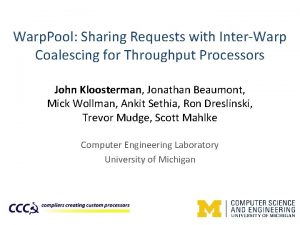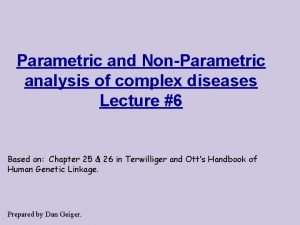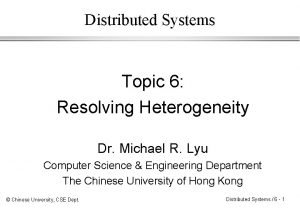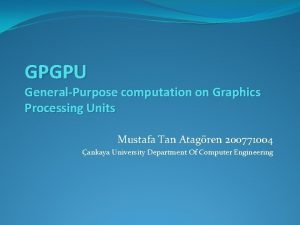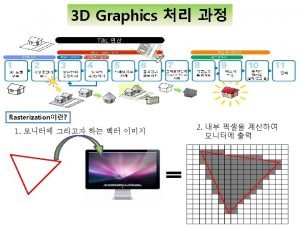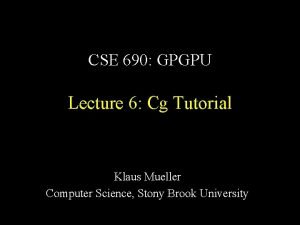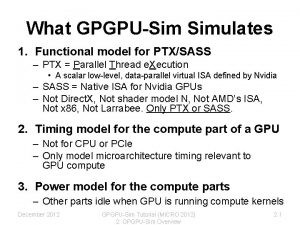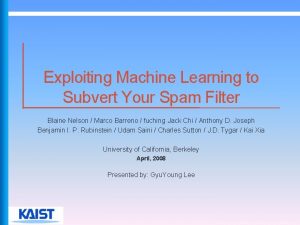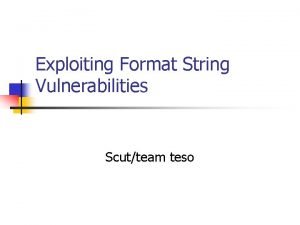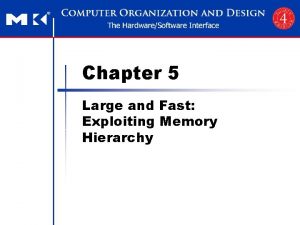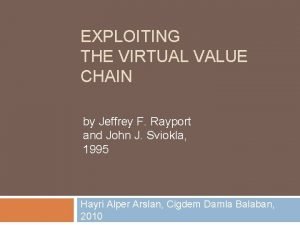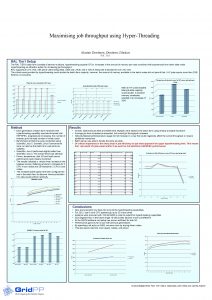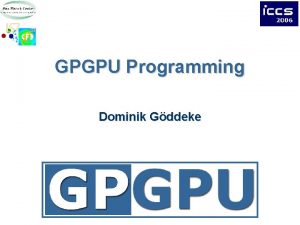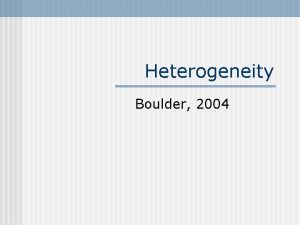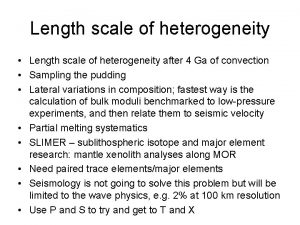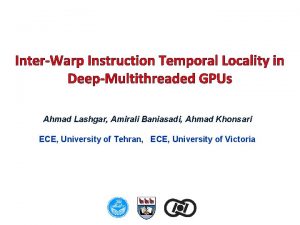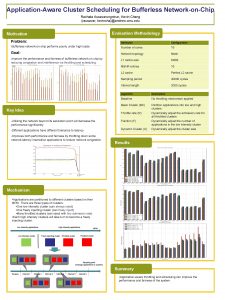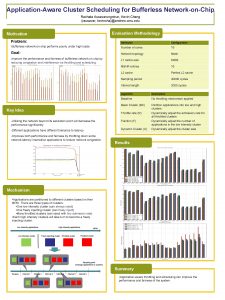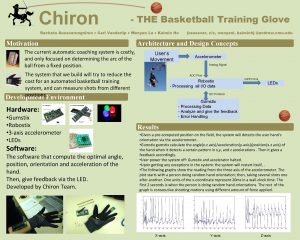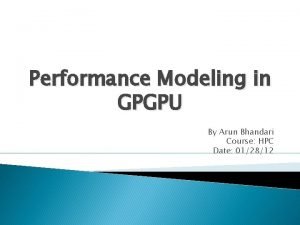Exploiting InterWarp Heterogeneity to Improve GPGPU Performance Rachata
























![Comparison Points • FR-FCFS baseline [Rixner+, ISCA’ 00] • Cache Insertion: – EAF [Seshadri+, Comparison Points • FR-FCFS baseline [Rixner+, ISCA’ 00] • Cache Insertion: – EAF [Seshadri+,](https://slidetodoc.com/presentation_image_h2/916821022955a40af737ab9cf81b2d4a/image-25.jpg)




















- Slides: 45

Exploiting Inter-Warp Heterogeneity to Improve GPGPU Performance Rachata Ausavarungnirun Saugata Ghose, Onur Kayiran, Gabriel H. Loh Chita Das, Mahmut Kandemir, Onur Mutlu

Overview of This Talk • Problem: memory divergence – Threads execute in lockstep, but not all threads hit in the cache – A single long latency thread can stall an entire warp • Key Observations: – – Memory divergence characteristic differs across warps Some warps mostly hit in the cache, some mostly miss Divergence characteristic is stable over time L 2 queuing exacerbates memory divergence problem • Our Solution: Memory Divergence Correction – Uses cache bypassing, cache insertion and memory scheduling to prioritize mostly-hit warps and deprioritize mostly-miss warps • Key Results: – 21. 8% better performance and 20. 1% better energy efficiency compared to state-of-the-art caching policy on GPU 2

Outline • • Background Key Observations Memory Divergence Correction (Me. Di. C) Results 3

Latency Hiding in GPGPU Execution Time GPU Core Status Warp A Warp B Active Warp C Warp D Stall Active Thread Lockstep Execution GPU Core 4

Problem: Memory Divergence Warp A Cache Hit Stall Time Main Memory Cache Miss Cache Hit 5

Outline • • Background Key Observations Memory Divergence Correction (Me. Di. C) Results 6

Observation 1: Divergence Heterogeneity Mostly-hit warp All-hit warp Mostly-miss warp All-miss warp Reduced Stall Time Cache Miss Cache Hit Key Idea: • Convert mostly-hit warps to all -hit warps • Convert mostly-miss warps to all-miss warps 7

Observation 2: Stable Divergence Char. • Warp retains its hit ratio during a program phase – Hit ratio number of hits / number of access 8

Observation 2: Stable Divergence Char. • Warp retains its hit ratio during a program phase Warp 2 Warp 3 Warp 4 Warp 5 Warp 6 Mostly-hit Balanced Cycles 1 M 0 K 95 0 K 90 0 K 85 0 K 80 0 K 75 0 K 70 0 K 65 0 K 60 0 K 55 0 K 50 0 K 45 0 K 40 0 K 35 0 K 30 0 K 25 0 K 20 0 K 15 10 0 K Mostly-miss K 1, 0 0, 9 0, 8 0, 7 0, 6 0, 5 0, 4 0, 3 0, 2 0, 1 0, 0 50 Hit Ratio Warp 1 9

Observation 3: Queuing at L 2 Banks Request Buffers Bank 0 Bank 1 Bank 2 …… …… Memory Scheduler To DRAM Bank n Shared L 2 Cache 45% of requests stall 20+ cycles at the L 2 queue Long queuing delays exacerbate the effect of memory divergence 10

Outline • • Background Key Observations Memory Divergence Correction (Me. Di. C) Results 11

Our Solution: Me. Di. C • Key Ideas: – Convert mostly-hit warps to all-hit warps – Convert mostly-miss warps to all-miss warps – Reduce L 2 queuing latency – Prioritize mostly-hit warps at the memory – Maintain memory bandwidth 12

Memory Divergence Correction Warp-type-aware Cache Bypassing Mostly-miss, All-miss Bank 1 Low Priority N Bank 2 High Priority …… Bypassing Logic Warp Type Identification Logic Memory Request Bank 0 Bank n Shared L 2 Cache Y To DRAM Any Requests in High Priority Warp-type-aware Memory Scheduler Warp-type-aware Cache Insertion Policy 13

Mechanism to Identify Warp Type • Profile hit ratio for each warp • Group warp into one of five categories All-hit Mostly-hit Balanced Higher Priority Mostly-miss All-miss Lower Priority • Periodically reset warp-type 14

Warp-type-aware Cache Bypassing Mostly-miss, All-miss Bank 1 Low Priority N Bank 2 High Priority …… Bypassing Logic Warp Type Identification Logic Memory Request Bank 0 Bank n Shared L 2 Cache Y To DRAM Any Requests in High Priority Warp-type-aware Memory Scheduler Warp-type-aware Cache Insertion Policy 15

Warp-type-aware Cache Bypassing • Goal: – Convert mostly-hit warps to all-hit warps – Convert mostly-miss warps to all-miss warps • Our Solution: – All-miss and mostly-miss warps Bypass L 2 – Adjust how we identify warps to maintain miss rate • Key Benefits: – More all-hit warps – Reduce queuing latency for all warps 16

Warp-type-aware Cache Insertion Warp-type-aware Cache Bypassing Mostly-miss, All-miss Bank 1 Low Priority N Bank 2 High Priority …… Bypassing Logic Warp Type Identification Logic Memory Request Bank 0 Bank n Shared L 2 Cache Y To DRAM Any Requests in High Priority Warp-type-aware Memory Scheduler Warp-type-aware Cache Insertion Policy 17

Warp-type-aware Cache Insertion • Goal: Utilize the cache well – Prioritize mostly-hit warps – Maintain blocks with high reuse • Our Solution: – All-miss and mostly-miss Insert at LRU – All-hit, mostly-hit and balanced Insert at MRU • Benefits: – All-hit and mostly-hit are less likely to be evicted – Heavily reused cache blocks from mostly-miss are likely to remain in the cache 18

Warp-type-aware Memory Sched. Warp-type-aware Cache Bypassing Mostly-miss, All-miss Bank 1 Low Priority N Bank 2 High Priority …… Bypassing Logic Warp Type Identification Logic Memory Request Bank 0 Bank n Shared L 2 Cache Y To DRAM Any Requests in High Priority Warp-type-aware Memory Scheduler Warp-type-aware Cache Insertion Policy 19

Not All Blocks Can Be Cached • Despite best efforts, accesses from mostly-hit warps can still miss in the cache – Compulsory misses – Cache thrashing • Solution: Warp-type-aware memory scheduler 20

Warp-type-aware Memory Sched. • Goal: Prioritize mostly-hit over mostly-miss • Mechanism: Two memory request queues – High-priority all-hit and mostly-hit – Low-priority balanced, mostly-miss and all-miss • Benefits: – Mostly-hit warps stall less 21

Me. Di. C: Example Mostly-miss Warp Cache Queuing Latency All-miss Warp Bypass Cache Lower queuing latency DRAM Queuing Latency Cache/Mem Latency Insert at LRU Mostly-hit Warp High All-hit Warp Priority Insert at MRU Lower stall time 22

Outline • • Background Key Observations Memory Divergence Correction (Me. Di. C) Results 23

Methodology • Modified GPGPU-Sim modeling GTX 480 – 15 GPU cores – 6 memory partition – 16 KB 4 -way L 1, 768 KB 16 -way L 2 – Model L 2 queue and L 2 queuing latency – 1674 MHz GDDR 5 • Workloads from CUDA-SDK, Rodinia, Mars and Lonestar suites 24
![Comparison Points FRFCFS baseline Rixner ISCA 00 Cache Insertion EAF Seshadri Comparison Points • FR-FCFS baseline [Rixner+, ISCA’ 00] • Cache Insertion: – EAF [Seshadri+,](https://slidetodoc.com/presentation_image_h2/916821022955a40af737ab9cf81b2d4a/image-25.jpg)
Comparison Points • FR-FCFS baseline [Rixner+, ISCA’ 00] • Cache Insertion: – EAF [Seshadri+, PACT’ 12] • Tracks blocks that are recently evicted to detect high reuse and inserts them at the MRU position • Does not take divergence heterogeneity into account • Does not lower queuing latency • Cache Bypassing: – PCAL [Li+, HPCA’ 15] • Uses tokens to limit number of warps that gets to access the L 2 cache Lower cache thrashing • Warps with highly reuse access gets more priority • Does not take divergence heterogeneity into account – PC-based and Random bypassing policy 25

Baseline 2, 5 EAF PCAL Me. Di. C 2, 0 21. 8% 1, 5 1, 0 ge er a SP Av SS ST M DM R BH S BF SS R PV C PV IIX SC HS BP P SC CO NS 0, 5 NN Speedup Over Baseline Results: Performance of Me. Di. C is effective in identifying warp-type and taking advantage of divergence heterogeneity 26

Baseline 4, 0 EAF PCAL Me. Di. C 3, 5 3, 0 2, 5 2, 0 20. 1% 1, 5 1, 0 ge er a SP Av SS ST M DM R BH S BF SS R PV C PV IIX SC HS BP P SC CO NS 0, 5 NN Norm. Energy Efficiency Results: Energy Efficiency of Me. Di. C Performance improvement outweighs the additional energy from extra cache misses 27

Other Results in the Paper • Breakdowns of each component of Me. Di. C – Each component is effective • Comparison against PC-based and random cache bypassing policy – Me. Di. C provides better performance • Analysis of combining Me. Di. C+reuse mechanism – Me. Di. C is effective in caching highly-reused blocks • Sensitivity analysis of each individual components – Minimal impact on L 2 miss rate – Minimal impact on row buffer locality – Improved L 2 queuing latency 28

Conclusion • Problem: memory divergence – Threads execute in lockstep, but not all threads hit in the cache – A single long latency thread can stall an entire warp • Key Observations: – – Memory divergence characteristic differs across warps Some warps mostly hit in the cache, some mostly miss Divergence characteristic is stable over time L 2 queuing exacerbates memory divergence problem • Our Solution: Memory Divergence Correction – Uses cache bypassing, cache insertion and memory scheduling to prioritize mostly-hit warps and deprioritize mostly-miss warps • Key Results: – 21. 8% better performance and 20. 1% better energy efficiency compared to state-of-the-art caching policy on GPU 29

Exploiting Inter-Warp Heterogeneity to Improve GPGPU Performance Rachata Ausavarungnirun Saugata Ghose, Onur Kayiran, Gabriel H. Loh Chita Das, Mahmut Kandemir, Onur Mutlu

Backup Slides 31

-1 16% 14% 12% 10% 8% 6% 4% 2% 0% 20 9 -3 40 9 -5 60 9 -7 80 9 10 - 9 0 9 12 11 0 9 14 13 0 9 16 15 0 9 18 17 0 9 20 19 0 9 22 21 0 9 24 23 0 9 26 25 0 9 28 27 0 9 -2 99 30 0+ 0 Fract. of L 2 Requests Queuing at L 2 Banks: Real Workloads 53. 8% Queuing Time (cycles) 32

Normalized Performance Adding More Banks 1, 6 12 Banks 2 Ports 24 Banks 4 Ports 1, 4 24 Banks 2 Ports 48 Banks 2 Ports 1, 2 5% 1, 0 0, 8 0, 6 0, 4 0, 2 0, 0 NN CONS SCP BP HS SC IIX PVC PVR SS BFS BH DMR MST SSSP Aver age 33

ST Av ge er a SS SP M R M D S BH BF SS R PV C PV IIX Baseline SC S H 30 BP 35 P 40 SC S N O C N N Queuing Latency (cycles) Queuing Latency Reduction 88. 5 WByp Me. Di. C 25 20 69. 8% 15 10 5 0 34

Speedup Over Baseline Me. Di. C: Performance Breakdown WIP 2, 5 WMS WByp Me. Di. C 2, 0 1, 5 1, 0 0, 5 NN CONS SCP BP HS SC IIX PVC PVR SS BFS BH DMR MST SSSP Aver age 35

ST Av ge er a SS SP M R M 0, 8 D S BH BF SS R PV C PV IIX SC S H BP P SC S N O C N N L 2 Cache Miss Rate Me. Di. C: Miss Rate 1, 0 Baseline Rand WIP Me. Di. C 0, 6 0, 4 0, 2 0, 0 36

ag e er SP SS M ST R M BH S BF SS R PV C PV IIX WMS Av S SC H Baseline D P 1, 0 BP SC S N O C N N Row Buffer Hit Rate Me. Di. C: Row Buffer Hit Rate Me. Di. C 0, 9 0, 8 0, 7 0, 6 0, 5 0, 4 37

Me. Di. C-Reuse 2, 4 Speedup Over Baseline 2, 2 Me. Di. C-reuse 2, 0 1, 8 1, 6 1, 4 1, 2 1, 0 0, 8 NN CONS SCP BP HS SC IIX PVC PVR SS BFS BH DMR MST SSSP Aver age 38

300 250 L 2 + DRAM 200 150 100 50 Max. Penalty from Divergence 0 NN CONS SCP BP HS SC IIX PVC PVR SS BFS BH DMR MST SSSP 350 900 700 0 NN CONS SCP BP HS SC IIX PVC PVR SS BFS BH DMR MST SSSP Avg. Penalty from Divergence L 2 Queuing Penalty 1 000 L 2 800 L 2 + DRAM 600 500 400 300 200 100 39

Divergence Distribution 40

Divergence Distribution 41

Stable Divergence Characteristics • Warp retains its hit ratio during a program phase • Heterogeneity – Control Divergence – Memory Divergence – Edge cases on the data the program is operating on – Coalescing – Affinity to different memory partition • Stability – Temporal + spatial locality 42

Warps Can Fetch Data for Others • All-miss and mostly-miss warps can fetch cache blocks for other warps – Blocks with high reuse – Shared address with all-hit and mostly-hit warps • Solution: Warp-type aware cache insertion 43

Warp-type Aware Cache Insertion Future Cache Requests MRU LRU A 1 A 2 LRU MRU LRU A 3 A 4 LRU B 1 A 5 A 6 B 2 A 7 B 3 A 8 A 9 B 2 MRU L 2 Cache 44

Warp-type Aware Memory Sched. Memory Request Warp Type All-hit, Mostly-hit High Priority Queue Balanced, Mostly-miss, All-miss Memory Request Low. Queue Priority Queue Memory FR-FCFS Scheduler Main Memory 45
 Interwarp
Interwarp Allelic heterogeneity
Allelic heterogeneity Aer strategy marketing
Aer strategy marketing Allelic heterogeneity
Allelic heterogeneity 324marketing
324marketing Allelic heterogeneity
Allelic heterogeneity Example of outgroup homogeneity effect
Example of outgroup homogeneity effect Heterogeneity distributed systems
Heterogeneity distributed systems Savana
Savana Gpugpu
Gpugpu Bus access module for scc
Bus access module for scc Gpu computing matlab
Gpu computing matlab Unicompiler
Unicompiler General purpose cpu
General purpose cpu Gpgpu tutorial
Gpgpu tutorial Kubernetes gpgpu
Kubernetes gpgpu Gpgpu sim tutorial
Gpgpu sim tutorial What is gpgpu
What is gpgpu Terminal server performance tuning
Terminal server performance tuning How to improve organisational performance
How to improve organisational performance Decision making unit example
Decision making unit example New entry in entrepreneurship
New entry in entrepreneurship Spamato
Spamato Pure-ftpd exploit
Pure-ftpd exploit Sem promotion
Sem promotion Large and fast: exploiting memory hierarchy
Large and fast: exploiting memory hierarchy What is virtual value chain
What is virtual value chain Aries algorithm
Aries algorithm Disadvantages of bell curve in performance appraisal
Disadvantages of bell curve in performance appraisal Jcids manual 2018
Jcids manual 2018 Chapter 11 performance appraisal - (pdf)
Chapter 11 performance appraisal - (pdf) Fokus secara kolektif terhadap pembelajaran murid
Fokus secara kolektif terhadap pembelajaran murid Kiss method keep, improve, start stop
Kiss method keep, improve, start stop How did john smith improve conditions in jamestown
How did john smith improve conditions in jamestown Interpersonal and intrapersonal skills examples
Interpersonal and intrapersonal skills examples Confucianism daoism and legalism
Confucianism daoism and legalism Cash flow forecast table
Cash flow forecast table Improve website usability
Improve website usability How did the hongwu emperor improve life for the peasants?
How did the hongwu emperor improve life for the peasants? To improve america's business ethics:
To improve america's business ethics: Can far memory improve job throughput
Can far memory improve job throughput If you can't measure it you cannot improve it
If you can't measure it you cannot improve it Noun suffixes
Noun suffixes Waarom dmaic
Waarom dmaic Wckcs
Wckcs Action plan for active listening
Action plan for active listening
